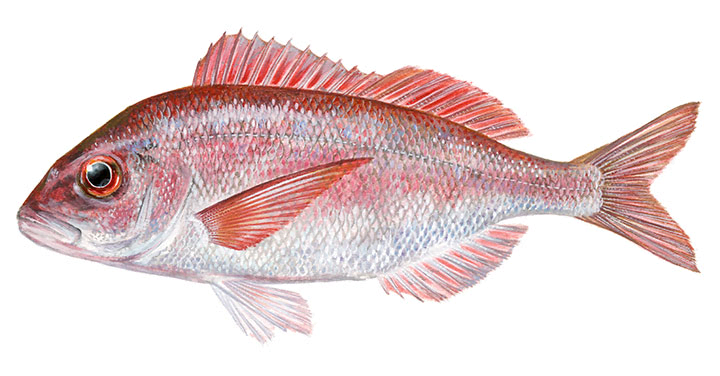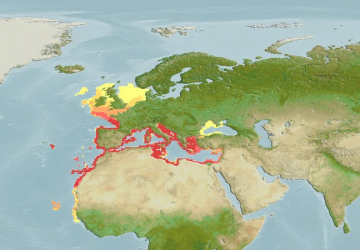Pagellus Erythrinus
– Common Pandora –


| Conservation status |
|---|
 Least Concern (IUCN 3.1)[1] |
| Scientific classification |
Pagellus erythrinus (Linnaeus, 1758)
| Kingdom: | Animalia |
| Phylum: | Chordata |
| Class: | Actinopterygii |
| Order: | Perciformes |
| Family: | Sparidae |
| Genus: | Pagellus |
| Species: | P. erythrinus |


The common pandora (Pagellus erythrinus) is a fish of the sea bream family, Sparidae. It is a popular food fish in Mediterranean countries, with delicate white flesh.
It has a slim, oval fusiform body, with a smallish mouth and scales covering its face. The eyes are smaller than those of Pagellus bogaraveo and Pagellus acarne. It is silver in colour with a pink tinge, particularly on its back. A typical specimen measures 10–30 cm, but it can reach as much as 50 cm in length.
The common pandora is a hermaphrodite, spending the first two years of its life as a female, and the third year as a male. It is omnivorous, but mainly feeds on smaller fish and benthic invertebrates. As most fishes, the common pandora harbours a variety of parasites. Philometra filiformis is a parasite nematode of the ovary of this fish.[2]
Biotope
The fish is found along the eastern shores Atlantic Ocean, from Scandinavia to Cape Verde, as well as the Mediterranean and the North Sea. In terms of genetic diversity, there appears to be a high level of connectivity from the Atlantic through the Mediterranean.[3]
It is a semi pelagic *, demersal * fish, that is to say, living near the bottom. It frequents coastal waters, on a variety of backgrounds (rocks, gravel, sands or mud) with a preference for loose substrates *. It is found between 5 and 200 m deep in the Mediterranean and up to 300 m in the Atlantic, but most often it is found between 20 and 100 m. It migrates in deeper water during the winter. Sometimes he enters the ports. The young are found closer to the coast than the adults.
Description
The common pandora is a fish whose common length is 15 to 30 cm, the maximum known size being 60 cm. The individuals observed by the divers are generally smaller than those marketed, caught in the circalittoral * often below 100 m.
The body is oval in shape, compressed laterally, as in most Sparidae.
The head has an almost straight profile , a pointed muzzle, a rather small mouth in a low and tilted position. The diameter of the eye is significantly less than the length of the muzzle . The inside of the mouth is greyish or whitish. The 2 jaws have pointed teeth at the front (larger external teeth, lined with small teeth) and at the rear2 or 3 rows of teeth in the form of molars .
Like all Sparidae it has only one dorsal fin. It begins directly above the pelvis and consists of 12 spines and 10-11 soft rays. The anal fin has 3 spines and 8-9 soft rays , the length of its base is one-third that of the dorsal. The pectoral fins are tall and very long, reaching almost vertical to the beginning of the anal fin. The caudal fin is forked.
The scales are ctenoid *. There are 55 to 65 scales at the lateral line. The muzzle, the suborbital region and the preoperculum are bare. The dorsal scales are present even in the space between the eyes.
Body color is silvery pink with bluish highlights, with darker back and top of the head. The upper part of the body is dotted with small blue dots . The adult is generally less pink than the young and the males are bluer during the breeding season. Bands of a slightly darker pink are reported and interpreted by some authors as a manifestation of fear. The upper outer edge of the operculum is marked with carmine red . The bases of the pectorals bear a reddish spot and sometimes there is also a spot at the base of the last rays of the dorsal fin.
Similar Species
There are risks of confusion with other pageots and especially with the common pagre, Pagrus pagrus . The difference with the latter is made at the level of the caudal fin, that of the pagre has white ends unlike that of the pageot.
Alimentation
The common pageot is a predominantly carnivorous omnivorous fish. It feeds mainly on small fish and benthic invertebrates * (worms, small crustaceans and molluscs).
Reproduction
It is a hermaphrodite protogynous species (first female then male), whose sexual maturity is reached for females after 1 to 2 years for a size of 15 to 17 cm. Some of the large females over 2 years old become males. The result is, in a population of pageots, more females than males (often double).
Reproduction takes place when the water temperature is between 19 and 21 ° C, from May to August (Mediterranean) from March to July (southern Portugal). There may be 2 spawning periods in the south of the area.
The laying is pelagic *, the gametes * are released in full water. The eggs give birth after 2 days of incubation at 21 ° C to a pelagic larva measuring about 2.5 mm. The fry then concentrate on shallow sites.
Associated Life
In the Bay of Biscay and in the Mediterranean, the anilocre Anilocra physodes mainly parasitizes pageots, bugs and sars by attaching itself to their flanks. The pageot can be the prey of other fish such as amberjack.
Various Biology
Pagellus erythrinus can live for more than 10 years, the age of some specimens has been estimated at 15 and even 21 years. Length and weight increase with age: for example, at 1 year about 12 cm, at 2 years about 16 cm (90 g), at 3 years about 17 to 20 cm (100 to 175 g). Individuals of 30 cm weigh more than 500 g and may be over 6 years old. Individuals between 40 and 50 cm are between 15 and 21 years old. The maximum published weight of an individual is 3.24 kg.
The species is gregarious but forms only small schools.
Further Information
This fish is rather wary, it is easier to approach at night.
The common pageot has an esteemed flesh and is usually found in the markets. It is the object of semi-industrial fishing (Spain, Italy, Cyprus), artisanal and sport. Various gears are used: seines, trawls, gillnets, bottom longline, traps and handlines. World fishing was close to 15,000 tonnes in the 1960s, 10,000 tonnes in the 1980s, 4,500 tonnes in the 2000s. Annual catches for France fell from 300 to 500 tonnes in the 1970s to around 120 tonnes in 1994. There is world aquaculture production of 119 tonnes.
This species is considered unsuitable for the aquarium hobby.










































































































































































































































































































































































